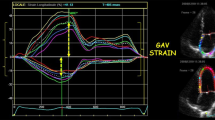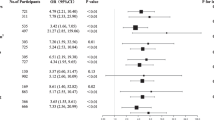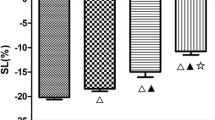Abstract
A wide range of subclinical changes in left ventricular (LV) geometry and function can be observed, even in the early course of arterial hypertension (HTN). Aim of the study was to investigate if the appearance of isolated basal septal hypertrophy (BSH, septal bulge) in asymptomatic young and middle-aged adults with HTN could be a marker of incipient LV systolic dysfunction when other measures of global LV function are still normal. A total of 138 patients with primary arterial hypertension, aged less than 65 years, with no comorbidities and with preserved LV ejection fraction (EF) were included. Complete 2D transthoracic echocardiography study was preformed according to standardized protocol, as well as deformation study using speckle tracking echocardiography. Global and regional longitudinal strain was measured in apical 4-, 2- and 3-chamber views according to 18-segments model. Global and regional circumferential and radial strains were measured in short axis view. Average was taken from each of the six basal, middle and apical LV segments. Patients were divided into two groups according to BSH presence and values were compared. Basal septal hypertrophy was found in half of the patients (53.6%). The whole cohort had altogether normal LV global systolic function, as well as global indices of radial strain (GRS 43.86 ± 10.75%) and longitudinal strain (GLS − 19.73 ± 2.19%), while global circumferential strain (GCS) was mildly reduced (GCS − 19.5 ± 2.81%). BSH patients had more expressed LV geometry changes (LV mass: 89.19 ± 24.59 g/m2 vs 109.15 ± 25.33 g/m2, p < 0.001; relative wall thickness: 0.3 ± 0.08 vs 0.38 ± 0.11, p < 0.001) and also revealed a specific pattern of longitudinal deformation impairment in three LV segments (basal and mid interventricular septum, basal anteroseptum). “Strain gradient” from LV base to apex (basal < mid < apical) was observed in the whole population for longitudinal and circumferential strain, and it was more pronounced in the BSH group. This group had more impaired basal LS, while apical CS was improved. Subendocardial longitudinal strain was also more impaired in the BSH group. This study brings new meaning to basal septal hypertrophy (BSH) occurrence in hypertensive patients with discrete global concentric remodeling. Regional systolic dysfunction of the basal and mid LV segments is found, while apical segments increase in deformation. This specific “strain gradient” pattern was found to be more pronounced in patients with BSH. The recognition of BHS in apparently healthy hypertensive patients with no impairment in global systolic function may suggest latent target organ damage with regional impairment of systolic function and the need to imply more aggressive treatment approach.





Similar content being viewed by others


References
Perrone-Filardi P, Coca A, Galderisi M et al (2017) Non-invasive cardiovascular imaging for evaluating subclinical target organ damage in hypertensive patients: a consensus paper from the European Association of Cardiovascular Imaging (EACVI), the European Society of Cardiology Council on Hypertension, and the European Society of Hypertension (ESH). Eur Heart J Cardiovasc Imaging 18(9):945–960
Braunwald E (2015) Braunwald’s heart disease: a textbook of cardiovascular medicine. Elsevier/Saunders, Philadelphia
Baltabaeva A, Marciniak M, Bijnens B et al (2008) Regional left ventricular deformation and geometry analysis provides insights in myocardial remodelling in mild to moderate hypertension. Eur J Echocardiogr 9:501–508
Sengupta A, Platts D (2013) Incidence of basal septal bulge in echocardiographic referrals. Heart Lung Circ 22(1):57
Verdecchia P, Porcellati C, Zampi I et al (1994) Asymmetric left ventricular remodeling due to isolated septal thickening in patients with systemic hypertension and normal left ventricular masses. Am J Cardiol 73(4):247–252
Nunez BD, Lavie CJ, Messerli FH, Schmieder RE, Garavaglia GE, Nunez M (1994) Comparison of diastolic left ventricular filling and cardiac dysrhythmias in hypertensive patients with and without isolated septal hypertrophy. Am J Cardiol 74(6):585–589
Mizuguchi Y, Oishi Y, Miyoshi H, Iuchi A, Nagase N, Oki T (2010) Concentric left ventricular hypertrophy brings deterioration of systolic longitudinal, circumferential, and radial myocardial deformation in hypertensive patients with preserved left ventricular pump function. J Cardiol 55:23–33
Masugata H, Senda S, Inukai M et al (2011) Differences in left ventricular diastolic dysfunction between eccentric and concentric left ventricular hypertrophy in hypertensive patients with preserved systolic function. J Int Med Res 39:772–779
Yingchoncharoen T, Agarwal S, Popovic ZB, Marwick TH (2013) Normal ranges of left ventricular strain: a meta-analysis. J Am Soc Echocardiogr 26:185–191
Di Bello V, Talini E, Dell’Omo G et al (2010) Early left ventricular mechanics abnormalities in prehypertension: a two-dimensional strain echocardiography study. Am J Hypertens 23:405–412
Sengupta PP, Krishnamoorthy VK, Korineck J et al (2007) Left ventricular form and function revisited: applied transplational science to cardiovascular ultrasound imaging. J Am Soc Echocardiogr 20:539–551
Maclver DH (2012) The relative impact of circumferential and longitudinal shortening on left ventricular ejection fraction and stroke volume. Exp Clin Cardiol 17(1):5–11
Voigt JU, Cvijic M (2019) 2- and 3-Dimensional myocardial strain in cardiac health and disease. JACC Cardiovasc Imaging 12(9):1849–1863
Marwick TH, Gillebert TC, Aurigemma G et al (2015) Recommendations on the use of echocardiography in adult hypertension: a report from the European Association of Cardiovascular Imaging(EACVI) and the American Society of Echocardiography (ASE). Eur Heart J 16:577–605
Lai YH, Lo CI, Wu YJ, Hung CL, Yeh HI (2013) Cardiac remodeling, adaptations and associated myocardial mechanics in hypertensive heart diseases. Acta Cardiol Sin 29:64–70
Hare JL, Brown JK, Marwick TH (2008) Association of myocardial strain with left ventricular geometry and progression of hypertensive heart disease. Am J Cardiol 102(1):87–91
Narayanan A, Aurigemma GP, Chinali M et al (2009) Cardiac mechanics in mild hypertensive heart disease: a speckle-strain imaging study. Circ Cardiovasc Imaging 2:382–390
Gaudron PD, Liu D, Scholza F et al (2016) The septal bulge—an early echocardiographic sign in hypertensive heart disease. J Am Soc Hypertens 10(1):70–80
Foppa M, Duncan BB, Rohde LEP (2005) Echocardiography-based left ventricular mass estimation. How should we define hypertrophy? Cardiovasc Ultrasound 3:17
James PA, Oparil S, Carter BL et al (2014) 2014 evidence-based guideline for the management of high blood pressure in adults: report from the panel members appointed to the Eighth Joint National Committee (JNC 8). JAMA 311(5):507–520
Lang RM, Badano L, Afilalo J et al (2015) Recommendations for cardiac chamber quantification by echocardiography: an update from the American Society of Echocardiography and the European Association of Cardiovascular Imaging. J Am Soc Echocardiogr 28:1–39
Nagueh SF, Smiseth OA, Appleton CP et al (2016) Recommendations for the evaluation of left ventricular diastolic function by echocardiography: an update from the American Society of Echocardiography and the European Association of Cardiovascular Imaging. Eur Heart J Cardiovasc Imaging 17:1321–1360
Sutherland GR, Hatle L, Claus P, Dhooge J, Bijnens BH (2006) Doppler myocardial imaging. A textbook: Chapter 4: A normal data. Springer, New York
Voigt JU, Pedrizzetti G, Lysyansky P et al (2015) Definitions for a common standard for 2D speckle tracking echocardiography: consensus document of the EACVI/ASE/Industry Task Force to standardize deformation imaging. Europ Heart J 16:1–11
Chen-Tournoux A, Fifer MA, Picard MH, Hung J (2008) Use of tissue doppler to distinguish discrete upper ventricular septal hypertrophy from obstructive hypertrophic cardiomyopathy. Am J Cardiol 101(10):1498–1503
Diaz T, Pencina MJ, Benjamin EJ et al (2009) Prevalence, clinical correlates, and prognosis of discrete upper septal thickening on echocardiography: the Framingham heart study. Echocardiography 26(3):247–253
Krishnamoorthy A, Brown T, Ayers CR et al (2011) Progression from normal to reduced left ventricular ejection fraction in patients with concentric left ventricular hypertrophy after long-term follow-up. Am J Cardiol 108:997–1001
Kishi S, Teixido-Tura G, Ning H et al (2015) Cumulative blood pressure in early adulthood and cardiac dysfunction in middle age. The CARDIA Study. J Am Coll Cardiol 65:2679–2687
Galderisi M, Lomoriello VS, Santoro A et al (2010) Differences of myocardial systolic deformation and correlates of diastolic function in competitive rowers and young hypertensives: a speckle-tracking echocardiography study. J Am Soc Echocardiogr 23:1190–1198
Palmon L, Reichek N, Yeon S et al (1994) Intramural myocardial shortening in hypertensive left ventricular hypertrophy with normal pump function. Circulation 89(1):122–131
Kucukler N, Yalcin F, Cingolani O et al (2011) Basal septal hypertrophy is an early imaging biomarker of hypertrophy in physiologic and pathologic stress. Circulation 124:A12802
Biederman RWW, Doyle M, Young AA et al (2008) Marked regional left ventricular heterogeneity in hypertensive left ventricular hypertrophy patients a losartan intervention for endpoint reduction in hypertension (LIFE) cardiovascular magnetic resonance and echocardiographic substudy. Hypertension 52:279–286
Mizuguchi Y, Oishi Y, Miyoshi H, Iuchi A, Nagase N, Oki T (2008) The functional role of longitudinal, circumferential, and radial myocardial deformation for regulating the early impairment of left ventricular contraction and relaxation in patients with cardiovascular risk factors: a study with two-dimensional strain imaging. J Am Soc Echocardiogr 21:1138–1144
Rademakers FE, Rogers WJ, Guier WH et al (1994) Relation of regional cross-fiber shortening to wall thickening in the intact heart. Three-dimensional strain analysis by NMR tagging. Circulation 89:1174–1182
Huang J, Yan ZN, Rui YF, Fan L, Shen D, Chen DL (2016) Left ventricular systolic function changes in primary hypertension patients detected by the strain of different myocardium layers. Medicine 95(2):2440
Tadic M, Cuspidi C, Vukomanovic V et al (2016) Does masked hypertension impact left ventricular deformation? J Am Soc Hypertens 10(9):694–701
Lee WH, Liu YW, Yang LT, Tsai WC (2016) Prognostic value of longitudinal strain of subepicardial myocardium in patients with hypertension. J Hypertens 34(6):1195–1200
Acknowledgements
We thank Marijan Pasalic for the statistical analysis of the data.
Funding
The authors have no relevant financial or non-financial interests to disclose.
Author information
Authors and Affiliations
Contributions
Both authors have contributed to the study equally. Data collection and analysis were performed by VRL. The first original draft of the manuscript was written by VRL. JSH designed the study concept and methodology, supervised and revised the paper critically with respect to important intellectual content. Both authors have approved the final version to be published, and agree to be accountable for all aspects of the paper and state that matters related to the accuracy and integrity of any part of the paper have been appropriately investigated and resolved.
Corresponding author
Ethics declarations
Conflict of interest
The authors declare that they have no conflict of interest.
Ethical approval
This study was performed in line with the principles of the Declaration of Helsinki. The approval was granted by the Ethics Committee of the University Hospital Centre Zagreb, School of Medicine.
Consent to participate
Informed consent was obtained from all individual participants included in the study.
Additional information
Publisher's Note
Springer Nature remains neutral with regard to jurisdictional claims in published maps and institutional affiliations.
Rights and permissions
About this article
Cite this article
Separovic Hanzevacki, J., Reskovic Luksic, V. Specific deformation pattern in hypertensive patients with septal bulge and preserved systolic function. Int J Cardiovasc Imaging 38, 2323–2331 (2022). https://doi.org/10.1007/s10554-022-02662-4
Received:
Accepted:
Published:
Issue Date:
DOI: https://doi.org/10.1007/s10554-022-02662-4


